

Requirements for Signaling of (Pre-) Congestion Information DiffServ Domain draft-karagiannis-pcn-signaling-requirements-00 Georgios Karagiannis, Tom Taylor, Kwok Chan, Michael Menth
Outline Goal of draft Requirements for signaling from PCN-egress- nodes to PCN-ingress-Nodes Requirements for PCN-egress-node to centralized decision point signaling Next steps
Goal of draft briefly describe PCN content and it specifies requirements that have to be satisfied by signaling protocol needed to transport this PCN content from PCN-egress-nodes towards either PCN-ingress-nodes or a centralized decision point; Notice: Current signaling requirements based on CL and SM edge behaviour drafts;
Requirements for signaling from PCN-egress- nodes to PCN-ingress-Nodes PCN Reporting Frequency content can be reported at regular intervals, in order 100ms to 300ms PCN Content requirements Admission control: Admission Control state: Admit (boolean true) Block (boolean false) either report all periodically generated PCN content (at the end of each measurement interval); or report only when PCN content changes, unless either ThM packets (for CL) or ETM packets (for SM) are observed. Then all periodically (per each measurement interval) must be reported.
Requirements for signaling from PCN-egress- nodes to PCN-ingress-Nodes PCN Content requirements Flow Termination Traffic rate: number of octets per second of PCN traffic carried in packets that are not excess-marked; List with flow Ids: to solve ECMP, a list of flow identifiers (e.g., IP five-tuples) to the decision point: either regularly at the end of each measurement interval; or when list, compared to previous measurement intervals, is being modified.
Requirements for signaling from PCN-egress- nodes to PCN-ingress-Nodes Signaling requirements General signaling requirements Priority of signaling messages: signaling messages SHOULD have a higher priority than data packets; Local information exchange: signaling messages MUST be able to carry PCN contents from PCN-egress-node to PCN-ingress-node; Carry identification of PCN edge nodes: signaling protocol MUST be able to carry identification (address information) of PCN edge nodes; Signaling load: load generated by signaling protocol to carry PCN content from PCN-egress- nodes to PCN-ingress-node SHOULD be minimized as much as possible.
Requirements for signaling from PCN-egress- nodes to PCN-ingress-Nodes Signaling requirements Reliability: There are situations that PCN contents need to be sent in a reliable way, meaning that PCN-egress-node MUST be acknowledged that sent PCN content is successfully received by the PCN-ingress-node; it is considered that the PCN contents that are sent in a regular fashion do not need to be sent reliably. Admission control signalling requirements Reliability: signaling protocol MUST be able to carry the "Admission control state", which MAY be carried reliably from the PCN-egress-node to the PCN-ingress-node.
Requirements for signaling from PCN-egress- nodes to PCN-ingress-Nodes Signaling requirements Flow Termination signaling requirements Reliability: signaling protocol MUST be able to carry the "Traffic rate", which MAY be carried reliably from PCN-egress-node to PCN-ingress-node; signaling protocol SHOULD be able to carry the "List with flow IDs", which MUST be carried reliably from PCN-egress-node to PCN-ingress-node.
Requirements for signaling from PCN-egress- nodes to PCN-ingress-Nodes Filter specifications: source IP address; destination IP address; protocol identifier and higher layer (port) addressing; flow label (typical for IPv6); SPI field for IPsec encapsulated data; DSCP/TOS field; IP address of PCN-ingress-node.
Requirements for signaling from PCN-egress- nodes to centralized decision points PCN Reporting Frequency, PCN Content requirements, Signaling requirements, Filter specifications similar with the ones defined for signaling from PC-egress to centralized decision points with following differences: PCN Content requirements: PCN contents need to be sent from the PCN- egress-node to centralized decision point; General signaling requirements: requirements applied for signaling messages that carry PCN contents from PCN-egress-node to centralized decision point; Carry identification of PCN edge nodes: signaling protocol MUST be able to carry identification (address information) of the PCN edge nodes and centralized decision point; identification (address information) of PCN-ingress-node MUST be included in signaling between PCN-egress-node and centralized decision point.
Requirements for signaling from PCN-egress- nodes to centralized decision points PCN Reporting Frequency, PCN Content requirements, Signaling requirements, Filter specifications similar with the ones defined for signaling from PC-egress to centralized decision points with following differences: Admission control signaling requirements: requirements applied for signaling messages that carry PCN contents from PCN-egress-node to centralized decision point; Flow Termination signaling requirements: requirements applied for signaling messages that carry PCN contents from PCN-egress-node to centralized decision point; Filter specifications: in addition to set of parameters listed previously, also "IP address of the centralized decision point“ needed.
Next steps We ask the support of the PCN working group such that the signaling requirements draft becomes a PCN working group draft.
Recommend
More recommend